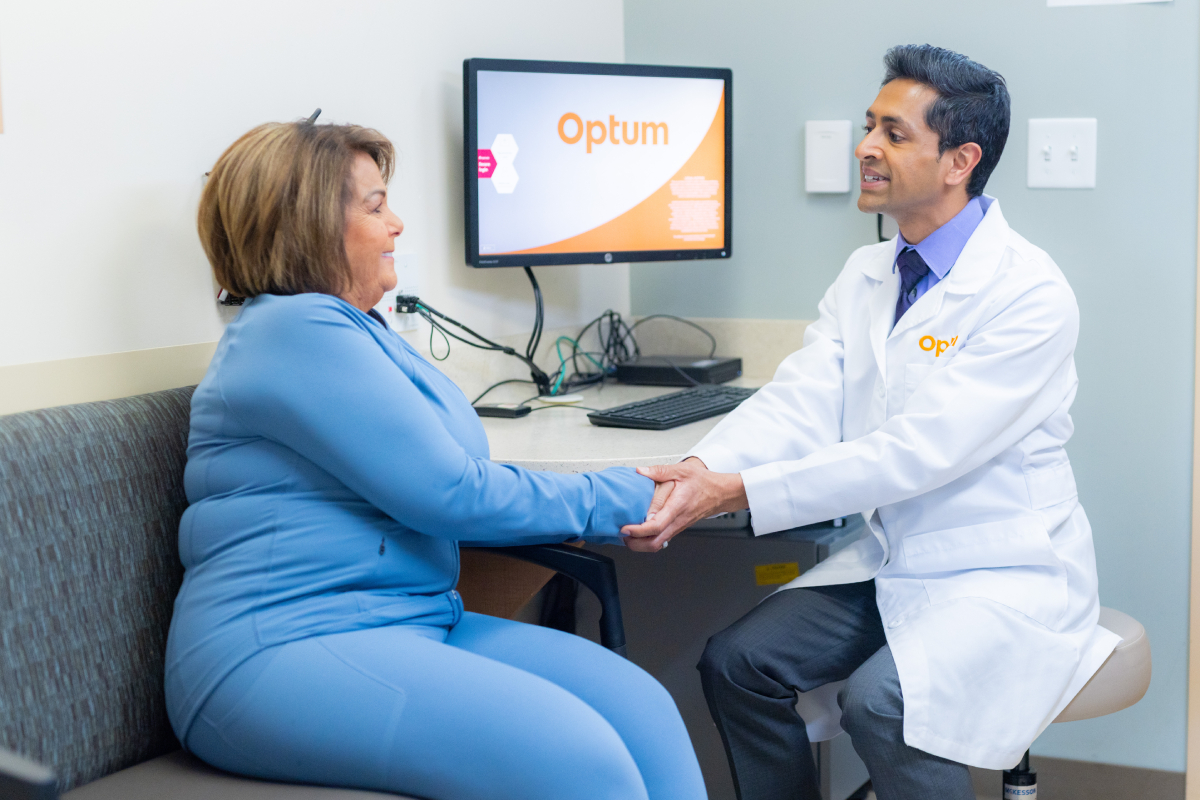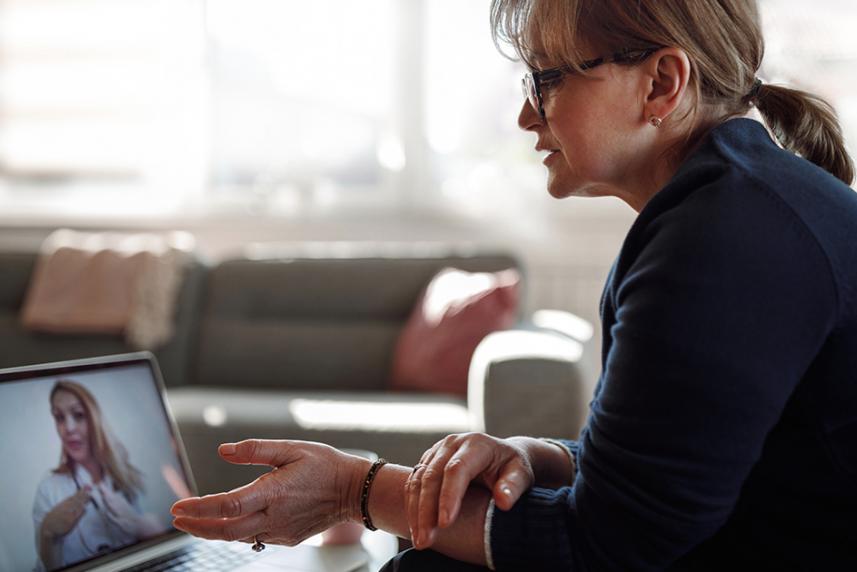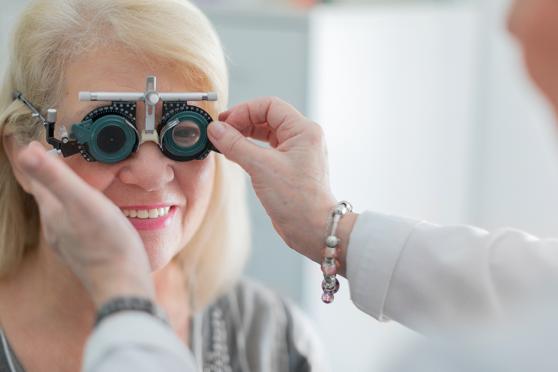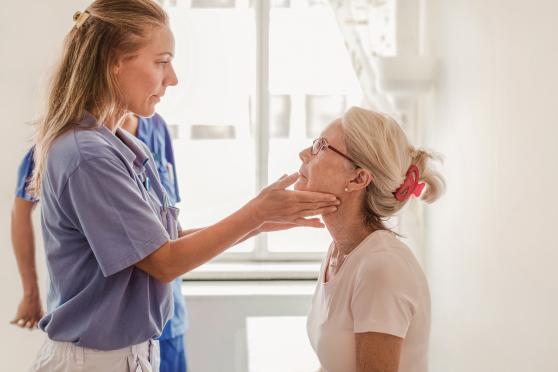
Ways to see your doctor (when you can’t get into the office)

New to telehealth? Not even sure what that means? Here’s what you need to know to prepare for a virtual doctor’s appointment.
Sometimes it’s not so easy getting in to see your doctor. Maybe you don’t feel well enough to drive yourself. Or you live in a rural area and there’s no transportation nearby. Or perhaps the weather is particularly bad or roads are unsafe. Or all that poking and prodding and blood work makes you anxious.
You wouldn’t be the first person to experience situations like these. They’re common. And thankfully, there are other ways to see your Optum doctors or specialists that don’t require physically being in your provider’s office.
That’s where telehealth comes in. (You might also see it called telemedicine or virtual care.) That’s a type of appointment you can have with your doctor over the phone or on a video call.1
“Telehealth really took off in popularity with COVID-19,” says Jill Stanton, MD, an Optum family medicine specialist based in Indianapolis. “COVID made it necessary for everyone to upgrade their technology at home and work, and patients are slowly learning that telehealth is a good option for certain visits.”
You can get a lot of the same great care you get in person during one of these appointments. Here’s what to know about telehealth and when you might want to schedule a virtual visit.

What’s the best type of telehealth appointment?
For telehealth visits, there are several ways you can talk with a health care professional. These include:1
- Speaking to them live over the phone
- Speaking to them live via video chat
- Sending and receiving secure messages through your online patient portal
To determine which type is best for your needs, consider the medical issue you’re having. “Video visits are preferred for any new problems that do not require an extensive physical exam,” says Dr. Stanton.
Obviously, you’d need to get an X-ray or blood draw in person. But even in those cases, Dr. Stanton says she can order labs or X-rays for a patient after a video visit. Those can then be done at the patient’s convenience.
A phone call appointment, on the other hand, may be best for follow-ups on treatment, says Dr. Stanton. These are usually conducted by a nurse.
In general, telehealth visits are best for health issues such as:1, 2
- Aches and pains
- Cold and flu symptoms
- Stomachaches
- Infections such as pink eye
- Rashes
- Uncomplicated urinary tract infections
Some Optum providers have gotten creative, offering hybrid virtual/in-person visits. At Dr. Stanton’s office, for example, a patient who has flu symptoms can drive to the office and park in a designated space in the parking lot. A nurse will come to the car with a tablet so the patient can “see” Dr. Stanton via video. At the same time, the nurse can take a patient’s vitals in their car and administer a COVID test or flu test.
On the other hand, most doctors ask patients to do annual physical exams in person. And while the annual wellness visits that are covered by Medicare can be done virtually, most providers prefer that you do those in person too.3, 4
How do you book a telehealth appointment?
Whether you have an Original Medicare plan or Medicare Advantage, you’ll have some telehealth benefits.4 You may want to call your provider just in case. They can tell you what types of benefits may be available to you.
Once you’re up to speed, it’s pretty easy to schedule a virtual visit:
- Call the doctor’s office to schedule an appointment. When you talk to the receptionist, they’ll be able to tell you whether that doctor offers virtual visits. That could be phone consults, video chats or both.
- Keep an eye out for a link. Once you’ve scheduled your appointment, you may be sent a link to log in to the patient portal for your appointment at a specific time. You might have to follow registration instructions to sign up for access to your patient portal, secure app or platform ahead of time.
When it’s time for your appointment, your doctor will appear on the other end of the line or video chat. You’ll talk to them just like you’d do in a face-to-face visit.
Having an Optum doctor means scheduling telehealth appointments is super easy. Find an Optum doctor.
Tips for having a successful telehealth visit
Here are some pointers to follow for telehealth, whether you’re doing a phone or video call:
Have your tech ready. Let’s say you’re doing a call on your smartphone. Make sure it’s fully charged, the volume is at a good level, and you are in a service area. If you’re doing a video call on your laptop, test your internet connection, camera and microphone to be sure they’re in working order.
“Most problems with telehealth calls occur due to technical problems,” says Dr. Stanton. Doctors at one New York City hospital also believed that technical problems posed challenges, according to a survey.5
If this is your first time seeing your doctor virtually, consider having a tech-savvy family member or friend on hand during your appointment to help with any technical issues, suggests Dr. Stanton.
Find the right spot. Set yourself up in a well-lit room so your doctor can see you.1 Make sure there’s no background noise. You’ll also want to keep a pen and paper handy for taking notes, says Dr. Stanton.
Prep your top questions. Before your appointment, write down any questions you may have for your doctor. This will ensure that you don’t forget to bring up anything important during the call. You can refer to your list as you chat with your doctor.
When you connect virtually with an Optum doctor or specialist, you’ll be getting the personal care you deserve. They’ll be able to walk you through a care or treatment plan. And you’ll be healthier because of it. That’s the Optum way.
Sources
- U.S. Department of Health and Human Services. What is telehealth? Last updated July, 27, 2023. Accessed January 30, 2024.
- Cleveland Clinic. What to expect when you log on for a virtual doctor’s appointment. Published August 16, 2023. Accessed January 25, 2024.
- Medicare.gov. Yearly “wellness” visits. Accessed January 25, 2024.
- Medicare.gov. Telehealth. Accessed January 25, 2024.
- Frontiers in Medicine. The feasiblity, accessibility and usability of telehealth visits. July 19, 2023. Accessed March 5, 2023.
© 2024 Optum, Inc. All rights reserved. Do not reproduce, transmit or modify any information or content on this website in any form or by any means without the express written permission of Optum.
The information featured in this site is general in nature. The site provides health information designed to complement your personal health management. It does not provide medical advice or health services and is not meant to replace professional advice or imply coverage of specific clinical services or products. The inclusion of links to other websites does not imply any endorsement of the material on such websites.
Stock photo. Posed by model.



